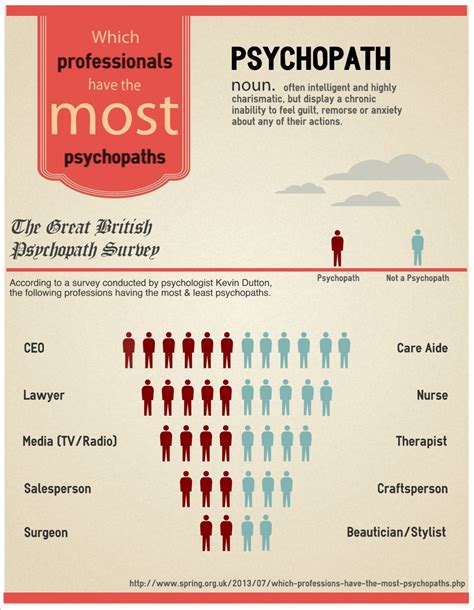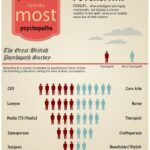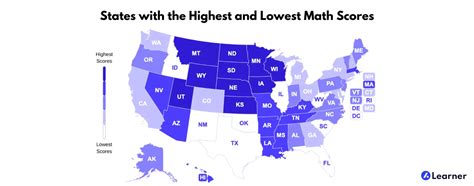
A recent study pinpointing states with the highest concentration of psychopathic personality traits reveals that Connecticut, Maine, and New York rank among the top, challenging preconceived notions about regional variations in personality. Using the “Dark Triad” personality traits – narcissism, Machiavellianism, and psychopathy – researchers analyzed data to determine the prevalence of these traits across the United States.
Connecticut leads the nation in exhibiting these darker personality characteristics, followed closely by Maine and New York. West Virginia and Maryland round out the top five, suggesting a potential cluster of these traits in the Northeast and Mid-Atlantic regions. The study, although not explicitly naming the researchers or the specific methodology employed in the Yahoo News report, indicates that these findings offer valuable insights into the geographical distribution of certain personality types.
The study assessed the prevalence of psychopathic traits, which, in the context of this research, do not necessarily imply criminal behavior but rather indicate a tendency towards manipulation, lack of empathy, and impulsivity. It’s crucial to understand the nuances of the term “psychopathic” in this context, as it differs significantly from clinical diagnoses of psychopathy or antisocial personality disorder.
The identification of these “psychopathic states” opens avenues for further research into potential contributing factors, such as socioeconomic conditions, cultural influences, and migration patterns. Understanding these dynamics could provide valuable context for interpreting the study’s findings and developing targeted interventions to address potential negative consequences associated with these personality traits.
Detailed Findings and Analysis:
The Yahoo News article highlights the surprising results of the study, revealing a geographic distribution of “Dark Triad” traits that deviates from common stereotypes. While many might expect states with high crime rates or densely populated urban centers to exhibit the highest levels of these traits, the study suggests a more nuanced picture.
Connecticut’s top ranking raises questions about the potential drivers of these personality characteristics within the state. Factors such as its high concentration of affluent communities, competitive professional environment, and historical socioeconomic factors could contribute to a higher prevalence of narcissistic and Machiavellian traits. Maine’s presence in the top three is particularly intriguing, given its relatively rural character and lower population density compared to other states on the list. This suggests that factors beyond urbanization and economic inequality may be at play. Potential explanations could involve unique cultural norms, historical migration patterns, or even environmental influences.
New York’s high ranking is perhaps less surprising, given its status as a major economic and cultural hub with a highly competitive environment. The state’s diverse population and fast-paced lifestyle could contribute to the development and expression of “Dark Triad” traits. West Virginia and Maryland’s inclusion in the top five further complicates the picture, suggesting that regional variations in these personality characteristics are influenced by a complex interplay of factors.
It is important to reiterate that the study focuses on the prevalence of “Dark Triad” traits and does not equate these traits with criminal behavior or mental illness. While individuals exhibiting these traits may be more prone to certain negative behaviors, such as manipulation and exploitation, they are not necessarily destined to engage in criminal activity or suffer from mental health disorders.
Implications and Future Research:
The study’s findings have significant implications for various fields, including psychology, sociology, and public health. Understanding the geographical distribution of “Dark Triad” traits can help researchers develop more targeted interventions to address potential negative consequences associated with these personality characteristics.
For example, interventions aimed at promoting empathy and ethical behavior could be particularly beneficial in states with a high prevalence of psychopathic traits. Similarly, interventions focused on reducing aggression and promoting conflict resolution could be valuable in areas with a high concentration of narcissistic and Machiavellian traits.
The study also raises important questions about the factors that contribute to the development and expression of “Dark Triad” traits. Future research should explore the role of socioeconomic conditions, cultural norms, environmental influences, and genetic factors in shaping these personality characteristics. Longitudinal studies that track individuals over time could provide valuable insights into the developmental trajectories of “Dark Triad” traits and their impact on behavior and well-being.
Moreover, research is needed to examine the relationship between “Dark Triad” traits and various social and economic outcomes. Do states with a high prevalence of these traits experience higher rates of crime, corruption, or social inequality? Are there any positive outcomes associated with these personality characteristics, such as increased innovation, entrepreneurship, or leadership effectiveness?
Understanding the “Dark Triad”: A Deeper Dive
To fully appreciate the significance of the study’s findings, it’s essential to understand the individual components of the “Dark Triad”:
- Narcissism: Characterized by an exaggerated sense of self-importance, a need for admiration, and a lack of empathy. Narcissists often believe they are superior to others and are entitled to special treatment. They may exploit others to achieve their goals and are often insensitive to the needs and feelings of those around them.
- Machiavellianism: Defined by a manipulative and exploitative approach to interpersonal relationships. Machiavellians are often cunning, deceitful, and willing to do whatever it takes to get ahead. They are skilled at manipulating others and are often adept at playing different roles to achieve their goals.
- Psychopathy: Marked by a lack of empathy, impulsivity, and antisocial behavior. Individuals with psychopathic traits often have a superficial charm but are emotionally shallow and incapable of forming genuine relationships. They may engage in criminal behavior or other antisocial acts without remorse.
It is important to emphasize that these traits exist on a continuum, and individuals may exhibit varying degrees of each characteristic. The study focuses on the prevalence of these traits within the general population and does not imply that all individuals in the identified states are psychopaths, narcissists, or Machiavellians.
Limitations and Considerations:
While the study provides valuable insights into the geographical distribution of “Dark Triad” traits, it’s important to acknowledge its limitations. The study relies on self-report data, which may be subject to biases such as social desirability bias. Individuals may be reluctant to admit to exhibiting socially undesirable traits, leading to an underestimation of the true prevalence of these characteristics.
Additionally, the study does not account for potential confounding variables, such as demographic differences between states. States with different age distributions, racial and ethnic compositions, or socioeconomic profiles may exhibit different levels of “Dark Triad” traits due to factors unrelated to the underlying psychological characteristics.
The Yahoo News article lacks the specific methodology used in the study, so there is no way to verify the reliability and validity of the findings. It is impossible to assess the sample size, the specific measures used to assess “Dark Triad” traits, or the statistical analyses employed. Therefore, the findings should be interpreted with caution and should be replicated by future research using more rigorous methodologies.
The Broader Context: Personality and Geography
The study’s findings contribute to a growing body of research exploring the relationship between personality and geography. Previous studies have shown that personality traits can vary significantly across different regions and cultures. For example, some studies have found that people in the Southern United States tend to be more agreeable and conscientious than people in the Northeastern United States. Other studies have found that people in collectivistic cultures tend to be more interdependent and less individualistic than people in individualistic cultures.
These regional variations in personality traits can be attributed to a variety of factors, including socioeconomic conditions, cultural norms, environmental influences, and genetic factors. Understanding these factors can help us to better understand the complex interplay between personality and geography.
The current study adds to this body of research by examining the geographical distribution of “Dark Triad” traits. While the study’s findings are preliminary and require further investigation, they suggest that these traits may also vary significantly across different regions of the United States.
Conclusion:
The study identifying Connecticut, Maine, and New York as states with a higher prevalence of “Dark Triad” personality traits offers a unique perspective on regional variations in personality. While the findings should be interpreted with caution due to the study’s limitations, they raise important questions about the factors that contribute to the development and expression of these traits.
Further research is needed to replicate these findings using more rigorous methodologies and to explore the potential implications of these traits for various social and economic outcomes. Understanding the geographical distribution of “Dark Triad” traits can help researchers develop more targeted interventions to address potential negative consequences associated with these personality characteristics and to promote positive social change. The key takeaway is the need for nuanced understanding and the avoidance of harmful stereotypes. This study represents a starting point for further exploration rather than a definitive statement about the character of specific states.
Frequently Asked Questions (FAQ)
1. What are the “Dark Triad” personality traits, and what do they mean in the context of this study?
The “Dark Triad” consists of three distinct but related personality traits: narcissism, Machiavellianism, and psychopathy.
- Narcissism is characterized by an inflated sense of self-importance, a deep need for excessive attention and admiration, troubled relationships, and a lack of empathy for others. While narcissism is often associated with arrogance, it also masks a fragile self-esteem vulnerable to the slightest criticism.
- Machiavellianism involves a manipulative and exploitative interpersonal style, a cynical disregard for morality, and a focus on self-interest and personal gain. Individuals high in Machiavellianism are often skilled at deceiving and manipulating others to achieve their goals, viewing others as mere tools to be used.
- Psychopathy is marked by a lack of empathy or remorse, antisocial behavior, impulsivity, selfishness, and a callous disregard for the feelings and welfare of others. It is important to note that this study is measuring psychopathic traits within the general population, not clinical psychopathy. Possessing these traits does not automatically mean someone is a criminal or has a mental disorder.
In the context of this study, the presence of these traits in a population does not necessarily indicate widespread criminal behavior or mental illness. Instead, it suggests a higher prevalence of individuals who may exhibit manipulative, self-centered, or impulsive tendencies. The study examines these traits as continuous variables rather than clinical diagnoses.
2. Does this study mean that people living in Connecticut, Maine, and New York are psychopaths?
No. It is crucial to understand that this study measures the prevalence of psychopathic traits within the general population of these states, not the presence of clinical psychopathy in all residents. The study suggests that, compared to other states, Connecticut, Maine, and New York have a higher proportion of individuals who exhibit characteristics associated with psychopathy, such as a lack of empathy, impulsivity, and a tendency toward manipulation. However, it does not mean that the majority of people in these states are clinically diagnosed psychopaths or that they are inherently dangerous or malicious. The traits are viewed on a spectrum, and the study does not provide individual-level diagnoses.
3. What factors might contribute to the higher prevalence of “Dark Triad” traits in these specific states?
Several factors could contribute to the observed differences in “Dark Triad” trait prevalence, although this study does not definitively identify specific causes. Potential contributing factors include:
- Socioeconomic conditions: Highly competitive environments and significant income inequality may foster narcissistic and Machiavellian traits as individuals strive for success and resources.
- Cultural norms: Certain cultural values that emphasize achievement, ambition, and individual success could inadvertently promote “Dark Triad” traits.
- Migration patterns: States with diverse populations and high rates of migration may experience a greater influx of individuals with varying personality characteristics.
- Environmental influences: Factors such as urbanization, population density, and exposure to stressors could influence personality development.
- Historical factors: Historical events and societal structures may have shaped cultural norms and personality traits over time.
- Demographic differences: Variations in age distribution, education levels, and other demographic characteristics between states could contribute to differences in personality trait prevalence.
It is likely that a combination of these and other factors contributes to the observed differences, and further research is needed to identify the specific drivers of “Dark Triad” trait prevalence in these states.
4. How was this study conducted, and what are its limitations?
The Yahoo News article, unfortunately, does not provide sufficient detail about the methodology used in the original study. It mentions the use of the “Dark Triad” personality traits as a framework for analysis but does not specify the data sources, sampling methods, or statistical analyses employed.
Therefore, it is difficult to assess the rigor and validity of the study’s findings. However, based on general knowledge of personality research, potential limitations could include:
- Self-report bias: If the study relied on self-report questionnaires, participants may have been reluctant to admit to exhibiting socially undesirable traits, leading to an underestimation of the true prevalence of “Dark Triad” traits.
- Sampling bias: The sample may not have been representative of the general population in each state, which could skew the results.
- Confounding variables: The study may not have adequately controlled for potential confounding variables, such as demographic differences between states, which could influence personality trait prevalence.
- Lack of longitudinal data: The study likely provided a snapshot in time and did not track individuals over time, which would be necessary to understand the developmental trajectories of “Dark Triad” traits and their impact on behavior.
- Ecological fallacy: Making inferences about individuals based on group-level data can lead to inaccurate conclusions. The study reveals state-level trends and cannot be applied to all residents of each state.
Without more information about the study’s methodology, it is important to interpret the findings with caution and to recognize that they may be subject to various biases and limitations.
5. What are the potential implications of this study for public policy and interventions?
While the study does not directly suggest specific policy recommendations, the findings could inform the development of targeted interventions to address potential negative consequences associated with “Dark Triad” traits.
Potential implications include:
- Mental health services: Increased awareness of the prevalence of “Dark Triad” traits could lead to improved access to mental health services for individuals who exhibit these characteristics, particularly those who are at risk for engaging in antisocial behavior.
- Educational programs: Educational programs designed to promote empathy, ethical behavior, and conflict resolution could be implemented in schools and communities to mitigate the negative effects of “Dark Triad” traits.
- Workplace interventions: Organizations could implement training programs to address manipulative behavior, promote ethical leadership, and foster a more positive work environment.
- Criminal justice system: Understanding the psychological characteristics of offenders with “Dark Triad” traits could inform rehabilitation efforts and risk assessment strategies.
- Social policies: Policies aimed at reducing socioeconomic inequality and promoting social cohesion could indirectly reduce the prevalence of “Dark Triad” traits by addressing some of the underlying social factors that contribute to their development.
It is important to emphasize that any policy or intervention should be evidence-based, carefully targeted, and designed to avoid stigmatizing or discriminating against individuals based on their personality traits. The focus should be on promoting positive social change and addressing the underlying causes of antisocial behavior, rather than simply labeling or punishing individuals.









